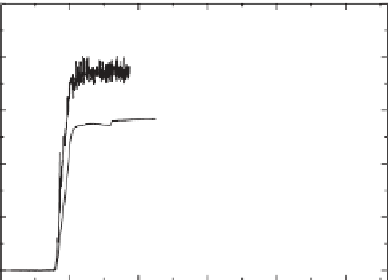Biomedical Engineering Reference
In-Depth Information
250
QCM
200
SPR
150
100
Rinse with water
50
0
0
500
1000
1500
2000
2500
Time (s)
Figure 4.13
Decoupling water content through the combination of QCM and SPR mea-
surements. The polymer used in this experimentwas a cationicpolyamide. The calculated
coupledwaterdeterminedbythismethodwasfoundtobe25%.
4.11
Lateral Force Microscopy
Both SPR and QCM allow for real time, in-situ monitoring of adsorption processes.
Although relevant to lubrication phenomena these adsorption techniques do not measure
friction behavior. Lateral Force Microscopy (LFM) is a technique that can directly
measure friction by lateral forces. These direct measurements allow for the evaluation
of lubricants' performance on specific surfaces with nanoscale resolution. LFM when
used with SPR and QCM techniques could unveil a more comprehensive understanding
of lubrication phenomena.
LFM is based on scanning probe microscopy and it is one of the few experimental
methods capable of assessing forces at the single contact or atomic level. LFM and
atomic force microscopy (AFM) share the same principles. A typical AFM comprises
three main components: laser source, cantilever and photo-detector (see Figure 4.14).
When an atomic force microscope (AFM) tip slides on a surface it is deformed both in
the vertical and the horizontal directions (Figure 4.14). The force
F
n
, which is normal
to the surface of the sample, results in vertical bending of the free end of the cantilever.
By contrast, the force
F
l
, which is parallel to the probed surface and is in the opposite
direction to the sliding direction, leads the cantilever into a twisting motion. A typical
AFM measures only the normal force,
F
n
. What distinguishes LFM form AFM, as the
name indicates, is that it measures both
F
n
and
F
l
.
In order to precisely detect the forces between the tip and the surface, a laser beam is
reflected off the back of the cantilever onto a quadrant photodiode detector. The output
of the quadrant detector is used to determine the degrees of bending and twisting of the
cantilever. The laser beam method is the most commonly used monitoring technique
as it can achieve a resolution comparable to that of an interferometer while it is also
inexpensive and easy to use. The availability of lateral force microscopy (LFM) has
made it possible to explore friction and wear at the molecular level and to examine the




Search WWH ::

Custom Search